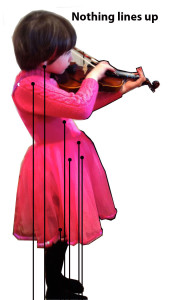Hey! I'm in California, getting ready for a certification week with our soon-to-be-Restorative Exercise grads from all over the world.Which is why I am very excited to have Restorative Exercise Specialist™ Chris Altman contribute today. One of the many things I love about Chris is her attention to detail. This is a fabulous blog post for musicians, parents of musicians and TEACHERS of music! Enjoy. (What's a week at "Alignment Camp" like? You can read a hilarious and not-at-all exaggerated account here --click.)
Part of becoming a Restorative Exercise Specialist™ is a week at the Institute, working on our own body. It was the Summer of 2011 where there I discovered how little my shoulder joint actually moved. During the thoracic stretch, we were cued to keep our eyes on the elbow pits and keep the pits pointed up to the ceiling. As I tried to bring my torso through my arms, the left arm would internally rotate and lock. I could barely raise the left arm above the shoulder without needing to rotate it. The next week was tortuously enlightening, since just about everything required better shoulder mobility than I could achieve and I became aware of all these compensations I had developed to hide it.
As I challenged myself to get that arm to move correctly, I experienced flushes of warmth in my face and my eyesight would sharpen, leading me to think that whatever my restriction was, it was decreasing the amount of blood reaching my face and heaven-forbid, my brain.
After that (long) week, I was able to mobilize my arm, and many other body parts as well. But all the while, I just couldn’t figure out how it happened to my shoulder. I’d had no injuries or accidents, or overuse from sports or work.
It was a couple of days before I realized, a-ha! How about playing violin for the last 30 years?
As soon as I returned home, I looked up shoulder impingement and string players and was shocked at what an extensive issue it is. There are thousands of research articles on various instruments and injury and they find 50-80% of string players will have a shoulder injury or pain.
One compromised shoulder in the family was bad enough. What about the fact that both my five-year-olds had been playing stringed instruments (violin and cello) seriously for the last year? What’s serious for a five-year-old? Fifteen to thirty minutes of playing 3-5 days a week. Surely that wasn’t enough to affect them? Well, of course, it is.
I immediately applied the biomechanics I learned as a Restorative Exercise Specialist™ to the repetitive motions used by musicians.

Once I noticed the patterns, I saw them everywhere. Observing instructors, watching recitals, all the while analyzing the alignment of children (and their teachers) engaged in playing their instruments and how they move afterwards. For my graduation project, I compiled my observations, considering carefully each component of form and stripping away those that were purely aesthetic, leaving just what is biomechanically necessary to make music, and then tested it as a musician.
I created a prescription of correctives of Restorative Exercise™ for myself and my daughters and been using it after each practice session to the benefit of our hands, shoulders, and neck.
The Restorative Exercise™ program functions as both the tool for motor skill analysis, and the prescription for restoration in areas found lacking. Applying this analytic tool after each playing session has allowed me to objectively observe any consequences of the activity. I have found that:
1. Playing most modern instruments is damaging. Some more than others.
2. There is no safe amount of time to play, i.e. the damage isn’t only occurring in prodigies and professionals who play many hours a day, but even in those who play a little bit. This is a similar phenomenon to those same exercise injuries found in those who range from weekend warriors to Olympians. What’s that all about??
3. The form necessary for the instrument is erroneously adopted and integrated into daily movements -- which it is not required.
and
4. Compensations due to fatigue create habitual malalignments.
Take my violinist daughter as an example:
Here is a candid image from December of 2010 right before she started taking lessons:

Here she is two years later. Notice how the humerus of both arms have rotated:

Her left shoulder is stiffer and had lost the reflex-driven reciprocal arm swing during gait, as had mine.
Some problems are inherent to correct violin-playing position, such as strain from holding the left shoulder in a static position that limits joint range of motion over time. Others are caused by poor alignment while standing or sitting or excessive tension in the hands, fingers, neck and jaw. Playing any instrument is difficult, and kids are challenged to the limit figuring out how to do it. As a musician and parent, I realize that we must provide the limits for them, and not set a precedent of working through pain and fatigue.
I’ve also realized as a graduate that not enough emphasis is placed on the Whole Body. Too many times an arm, hand or foot position is corrected by an instructor without any attention to how that change affected the position of the ribs, hips or head. There is also the issue of incorrect instrument fit. This is what a child must do when a violin shoulder rest is the incorrect size or shape:

Habitual, unnatural positioning of the body can create fascial adhesions. See her flared rib that required extra fascial therapy:

As both a musician and a parent wanting to share my love of playing an instrument, I was very happy to find a simple answer to these questions about alignment and music-making. Knowing how to analyze motion and quantify it relative to natural movement is extremely helpful, as is knowing how to offer correctives. This is true for children and adults doing ANY sort of physical activity or sport...even violin playing. Knowing how to quantify a neutral position of the skeleton allows for changes in alignment to be recognized by a teacher or student before they become debilitating! And we all know that prevention is key
.
Christine Altman, RES-CPT, is owner of The Vital Gaitway, a facility dedicated to Restorative Exercise and Whole Body Alignment, serving Litchfield County, Connecticut and also offering Skype appointments for those further afield. Her “Alignment for Musicians” series of PDF handouts and videos is available through her website. She welcomes everyone who wants to learn Whole Body Alignment, and her mission is to educate teachers and coaches how to prevent habitual malalignments in children. Read more on her blog.